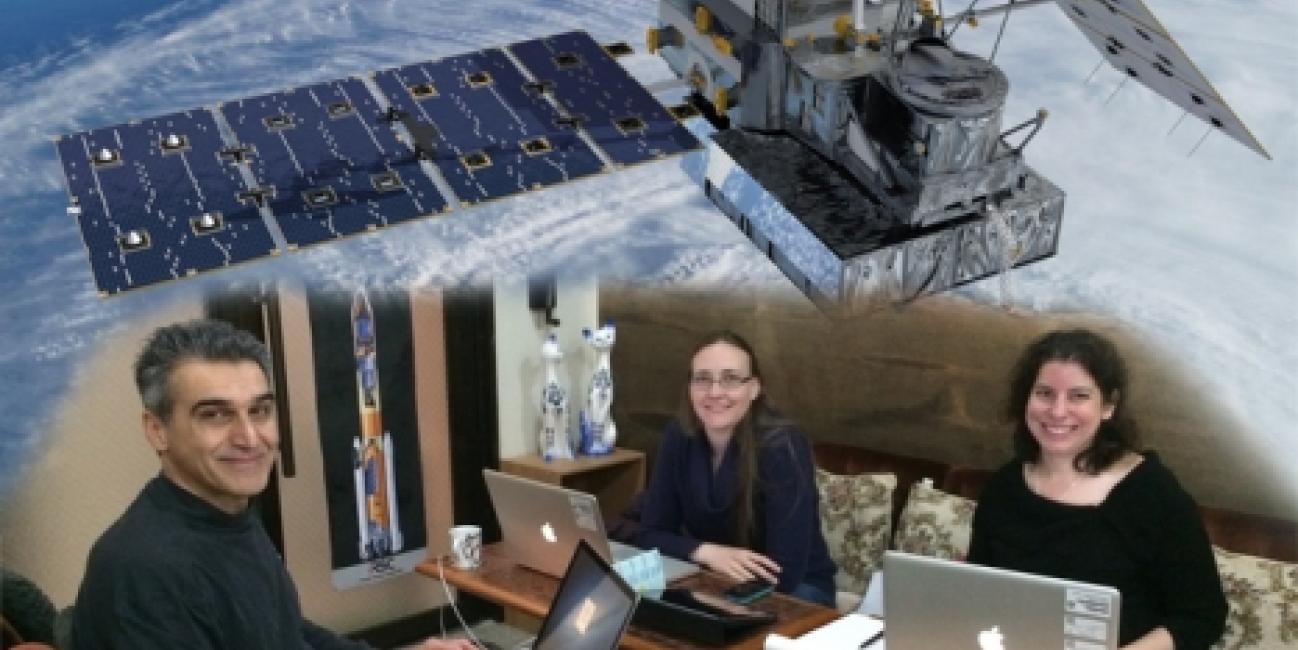
Live from Japan: GPM Tweet Chat Recap
Global Precipitation Measurement is a big mission. You've got questions? We've got answers.
Three days before launch of the Global Precipitation Measurement (GPM) Core Observatory from Tanegashima Space Center in Japan, NASA staff supporting the mission set up shop in the lobby of the Sun Pearl Hotel in nearby Minamitane for a live Twitter Q-and-A to answer questions about the mission and what it will do in orbit.
 GPM Project Manager Art Azarbarzin and supporting staff Ellen Gray and Rani Gran taking part in the GPM Twitter Q-and-A from the Sun Pearl Hotel on Feb. 25. They were also joined by NASA Goddard staff Jacob Reed, Aries Keck, Dalia Kirschbaum, and GPM Deputy Project Manager Cahdance Carlisle. Image Credit: NASA
GPM Project Manager Art Azarbarzin and supporting staff Ellen Gray and Rani Gran taking part in the GPM Twitter Q-and-A from the Sun Pearl Hotel on Feb. 25. They were also joined by NASA Goddard staff Jacob Reed, Aries Keck, Dalia Kirschbaum, and GPM Deputy Project Manager Cahdance Carlisle. Image Credit: NASADressed casually in a black long-sleeved T-shirt, GPM Project Manager Art Azarbarzin from NASA's Goddard Space Flight Center in Greenbelt, Md., arrived with his morning coffee in one hand and his laptop in the other. GPM Project Scientist Gail Skofronick-Jackson called in from an airport on her way to Tanegashima. GPM Applications Scientist Dalia Kirschbaum and Deputy Project Manager Candace Carlisle logged in from Goddard.
Below is a sample of highlights from the chat. Tweets have been edited for formatting, and some of the questions and answers have been combined and/or expanded. You can find the original tweets @NASA_Rain.
Tanegashima Space Center
Q: Is it distracting working at Tanegashima Space Center with all the beautiful scenery in the area?
Working at beautiful Tanegashima isn't distracting. Once you've seen the sights, you get used to it. Project Manager Art Azarbarzin says the views can be very soothing when the ocean view opens up driving to the space center.
Q: Why did NASA partner with the Japan Aerospace Exploration Agency for the GPM mission?
Missions as big as GPM are a large investment, so partnering with an interested agency helps bring down the cost. GPM is a global mission with a global team; we couldn’t do it without our international partners.
Science
Q: What is GPM and how does it differ from the current Tropical Rainfall Measuring Mission (TRMM)?
GPM is the next generation of precipitation observations. The instruments on GPM will be more accurate for rain measurements, and they'll be able to observe light rain, ice and snow, which are very difficult to measure from space. GPM will also have more coverage of Earth, observing from the Arctic to the Antarctic circles. Plus we are partnering with precipitation satellites from other countries and U.S. agencies to combine observations into a global data set several times a day.
TRMM, which launched from Tanegashima in 1997, has an orbit that covers the tropics, and it measures heavy to moderate rainfall. It has been in orbit and producing data for almost 17 years, well beyond its design life, and has an excellent record of precipitation that GPM will add to for a long-term record of precipitation that is important for studying Earth's climate.
Q: Does Earth lose water to space?
The water we have on Earth is the same water we’ve always had, and always will have, which is why it's important to monitor Earth's freshwater -- one of GPM's main goals. About 1 percent of the water on Earth is fresh water, but only 0.01 percent is actually usable by humans.
Q: How will GPM measurements of falling snow differ from what we have now? What's the benefit to science, forecasts?
GPM is the first precipitation mission specifically designed to measure falling snow. A lot is still unknown about snow, especially about how it behaves when it is still in the atmosphere. It's also difficult to measure from space because the ice particles are very small and look different to the satellite's instruments than liquid raindrops. As a result, while scientists can say something about snow with ground radars, where those radars can’t see, such as over the ocean or in mountainous regions, they really don't know how much or where the snow is falling. With GPM's data, scientists will be able to start answering some of those questions. And in turn, that will improve snow forecasts and our knowledge of water resources.
GPM Core Observatory
Q: How many instruments are on the GPM Core Observatory?
The GPM Core Observatory has two instruments: the GPM Microwave Imager (GMI) and the Dual-frequency Precipitation Radar (DPR). These instruments will provide advanced observations that will allow scientists to "see" inside clouds.
The GMI has the capability to measure the amount, intensity and type of precipitation, from heavy-to-moderate rain to near-imperceptible light rain to detecting snow. The DPR will return three-dimensional profiles and intensities of liquid and solid precipitation, in particular allowing estimation of raindrop size distributions. These data will reveal the internal structure of storms within and below clouds.
Q: If there is an issue with the spacecraft once it's in orbit, how will it be fixed?
Most issues on the GPM Core Observatory will be resolved by updating the software on the spacecraft.
Launch
Q: How long does a launch take?
From the spacecraft's arrival at the launch site, it takes three to four months to prepare for liftoff. The actual launch happens very quickly. The GPM Core Observatory will separate from the rocket about 15 minutes after launch, eventually settling at an orbit about 250 miles above Earth's surface.
Q: Where can we watch the launch?
Live coverage of the GPM launch will be broadcast on NASA TV starting at noon EST on Feb. 27. You can watch online at:http://www.nasa.gov/nasatv.

